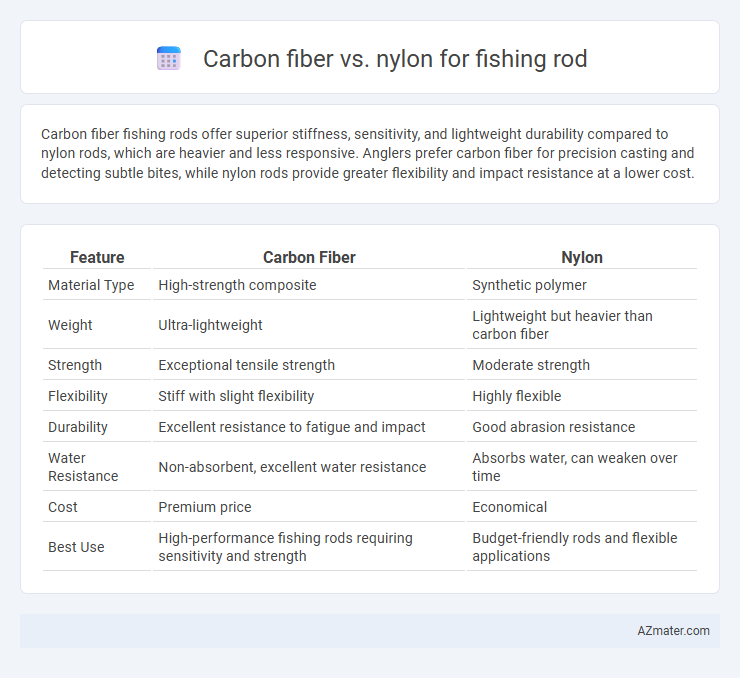Carbon fiber fishing rods offer superior stiffness, sensitivity, and lightweight durability compared to nylon rods, which are heavier and less responsive. Anglers prefer carbon fiber for precision casting and detecting subtle bites, while nylon rods provide greater flexibility and impact resistance at a lower cost.
Table of Comparison
| Feature | Carbon Fiber | Nylon |
|---|---|---|
| Material Type | High-strength composite | Synthetic polymer |
| Weight | Ultra-lightweight | Lightweight but heavier than carbon fiber |
| Strength | Exceptional tensile strength | Moderate strength |
| Flexibility | Stiff with slight flexibility | Highly flexible |
| Durability | Excellent resistance to fatigue and impact | Good abrasion resistance |
| Water Resistance | Non-absorbent, excellent water resistance | Absorbs water, can weaken over time |
| Cost | Premium price | Economical |
| Best Use | High-performance fishing rods requiring sensitivity and strength | Budget-friendly rods and flexible applications |
Introduction to Carbon Fiber and Nylon Fishing Rods
Carbon fiber fishing rods are renowned for their high strength-to-weight ratio, offering exceptional sensitivity and durability for demanding angling conditions. Nylon fishing rods, often made from nylon composites or used as guide materials, provide flexibility and impact resistance but lack the stiffness and responsiveness of carbon fiber. Anglers seeking lightweight performance and precision typically prefer carbon fiber, while nylon components contribute to increased rod toughness and resilience against abrasion.
Material Composition and Characteristics
Carbon fiber fishing rods feature a composition of tightly woven carbon filaments bonded with epoxy resin, providing exceptional strength-to-weight ratio and superior stiffness. Nylon rods, made from polyamide polymers, offer flexibility and durability but tend to be heavier and less sensitive than carbon fiber counterparts. The high tensile strength and low density of carbon fiber result in increased sensitivity and casting accuracy, whereas nylon's elasticity enhances shock absorption but sacrifices some responsiveness.
Weight and Sensitivity Comparison
Carbon fiber fishing rods are significantly lighter than nylon rods, enhancing ease of handling and reducing fatigue during extended fishing sessions. The superior rigidity of carbon fiber delivers increased sensitivity, enabling anglers to detect subtle bites and underwater movements more effectively. Nylon rods, while more flexible and durable, typically lack the heightened responsiveness that carbon fiber provides, making them less ideal for precise bite detection.
Strength and Durability Factors
Carbon fiber fishing rods offer superior strength and stiffness, providing excellent sensitivity and power for handling large fish. Nylon rods exhibit greater flexibility and impact resistance, enhancing durability under rough conditions and accidental knocks. The choice between carbon fiber's high tensile strength and nylon's resilience depends on fishing style and environmental challenges.
Flexibility and Action Performance
Carbon fiber fishing rods exhibit superior action performance due to their high stiffness-to-weight ratio, enabling precise and sensitive flex that enhances hook-setting efficiency. Nylon rods provide greater flexibility, offering a slower action that absorbs sudden shocks and is ideal for fighting aggressive fish, but they lack the responsiveness found in carbon fiber models. The choice between carbon fiber and nylon hinges on the desired balance between sensitivity and durability in specific fishing conditions.
Resistance to Environmental Factors
Carbon fiber fishing rods exhibit superior resistance to environmental factors such as UV radiation, saltwater corrosion, and temperature fluctuations, ensuring long-term durability and performance. Nylon rods, while more flexible and impact-resistant, are prone to degradation from prolonged sun exposure and moisture absorption, which can weaken their structure over time. Selecting carbon fiber enhances rod longevity in harsh marine environments, making it ideal for frequent saltwater fishing.
Cost and Value for Money
Carbon fiber fishing rods generally cost more than nylon rods due to their superior strength-to-weight ratio and durability, providing better performance for serious anglers. While nylon rods are more affordable and suitable for beginners, they lack the sensitivity and overall longevity of carbon fiber rods. For value-conscious anglers seeking long-term investment, carbon fiber offers greater return through enhanced casting accuracy and reduced fatigue despite the higher initial price.
Suitability for Different Fishing Techniques
Carbon fiber fishing rods offer exceptional sensitivity and strength, making them ideal for techniques that require precise lure control and quick hook sets, such as bass fishing and fly fishing. Nylon rods, known for their flexibility and durability, excel in heavy-duty applications like saltwater fishing and techniques involving large, aggressive fish, where shock absorption is crucial. Anglers should select carbon fiber for finesse and accuracy, while nylon suits demanding environments and species requiring robust, forgiving rods.
Maintenance and Longevity
Carbon fiber fishing rods require minimal maintenance due to their corrosion resistance and durability, making them ideal for saltwater environments and frequent use. Nylon rods, while less expensive, are more prone to wear and environmental damage, necessitating regular cleaning and drying to prevent weakening and extend lifespan. The superior tensile strength and fatigue resistance of carbon fiber contribute to its longer overall longevity compared to nylon.
Choosing the Best Rod Material for Your Needs
Carbon fiber fishing rods offer superior sensitivity, lightweight performance, and excellent strength, making them ideal for anglers seeking precision and durability. Nylon, often used in fiberglass rods, provides greater flexibility and impact resistance, suitable for beginners or those targeting larger, stronger fish species. Selecting the best rod material depends on fishing style, target species, and desired balance between sensitivity and toughness.

Infographic: Carbon fiber vs Nylon for Fishing rod
 azmater.com
azmater.com